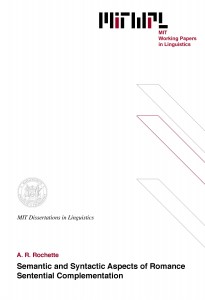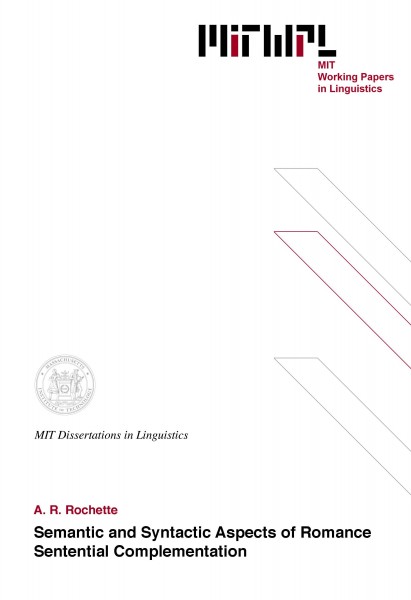Semantic and Syntactic Aspects of Romance Sentential Complementation
A. R. Rochette, 1988
This dissertation is a study of different semantic and syntactic aspects of sentential complementation in the Romance languages. A general theory of sentential complementation is developed to account both for the numerous syntactic differences found among the different types of sentential complements and for the selectional properties of the semantic classes of main predicates that select these complements.
In chapter 1, a semantic classification of main predicates is introduced. Three main classes of predicates are distinguished: effective, emotive, and propositional predicates. The major leading hypothesis of this disseration is also introduced in that chapter. It is argued that the three semantic classes of predicates s-select distinct semantic types of sentential complements which also correspond to distinct structural types of complements.
Chapter 2 is a study of the complements of effective verbs. It is argued that the effective verbs select the semantic type action and that the structural realization of action is a projection of the category V, usually an infinitival complement in Romance. A good part of the chapter is concerned with the analysis of the so-called restructuring phenomenon. It is argued that the crucial property underlying restructuring is the possibility for certain matrix verbs to not have an E-position in their thematic grids. When these matrix verbs lack an E-position they behave like auxiliary verbs and the matrix INFL can theta-bind an E-position of the embedded predicate. It is also argued that the prepositions that introduce complements to effective verbs should be analyzed as instances of Case spelling rather than as complementizers. With some effective verbs, action can also be realized as a projection of the category N. It is shown that these complements are necessarily interpreted as "concealed actions".
Chapter 3 is a study of the complements to emotive verbs. It is argued that the emotive verbs select the semantic type event and that the structural realization of event is a projection of the category INFL. Depending on the value of the feature (Tense) under INFL, the complement will either appear as a subjunctive complement or as an infinitival complement. Different phenomena characteristic of subjunctive complements are examined, such as the well-known obviative phenomenon and other transparency effects which are analyzed as following form the fact that the head of the complement is INFL. It is also argued that the possible presence of certain types of sentential operators (factivity, modality, etc.) may create some opacity effects for these subjunctive complements. Certain syntactic constructions that appear to distinguish the complements to emotive verbs from the other types of complements are also studied in that chapter and it is argued in each case that their existence provides further evidence in support of a structural distinction of the complements to emotive verbs.
In chapter 4, the complements to propositional verbs are examined. It is argued that propositional verbs select the semantic type proposition and that the structural realization of proposition is normally a projection of the category COMP. It is shown that this claim accounts for the Romance infinitival complements to propositional verbs but appears to be contradicted by the behavior of the English infinitival complements which are often analyzed as IP"s rather than CP"s. An analysis in terms of Case-marking differences between English and the Romance languages is developed to account for this difference.
Thesis supervisor: Noam Chomsky
Title: Institute Professor
Table of Contents
Chapter 1 Introduction 9
1.1 Introduction to the thesis 11
1.1.1 Semantic verb classes 18
1.1.2 Syntactic differences among sentential complements 24
1.1.2.1 The restructuring construction 27
1.1.2.2 Verbs of obligatory control 29
1.1.2.3 Subjunctive vs. indicative 32
1.1.2.4 Exceptional Case Marking 33
1.1.3 The syntactic differences correlate with semantic classes 34
1.1.4 The theory of semantic selection 36
1.1.4.1 S-selection and c-selection 37
1.1.4.2 Actions, events and propositions 42
1.1.4.3 The canonical lexical realization 45
1.1.5 The limits of this study 47
1.2 Introduction to the theoretical framework 51
1.3 The thesis in a nutshell 57
Notes to chapter 1 59
Chapter 2 Effective verbs
2.1 Introduction 60
2.2 The complements to "restructuring" verbs 73
2.2.1 The restructuring construction 76
2.2.2 Restructuring is the absence of an embedded INFL 81
2.2.2.1 Manifestations of INFL 85
2.2.2.2 Object preposing 91
2.2.2.3 Clitic-climbing 96
2.2.2.4 The change of auxiliary phenomenon 108
2.2.3 The interpretation of restructuring structures 115
2.3 Modern French vs. Old French and other Romance languages 124
2.3.1 The placement of clitics in Romance 129
2.3.1.1 Clitics under VP 131
2.3.1.2 Clitics under INFL 133
2.3.2 The null subject parameter 136
2.3.3 The nominal character of infinitives 138
2.3.4 Explaining the change from Old French to Modern French 141
2.4 The theoretical implications of VP complements 144
2.4.1 The Extended Projection Principle 145
2.4.2 The Theta-criterion 147
2.4.3 The raising/control distinction 148
2.5 Infinitival complements introduced by de/a 172
2.5.1 The distribution of infinitivals introduced by de/a 173
2.5.2 The status of de/a 175
2.5.2.1 Kayne (1981) 177
2.5.2.2 Manzini (1982) 181
2.5.2.3 Rizzi (1982) 185
2.5.3 Case-marking and the status of the prepositions 188
2.5.3.1 The effective verbs 189
2.5.3.2 The emotive verbs 198
2.5.3.3 The propositional verbs 207
2.6 The S-selection of effective verbs 209
2.7 Rumanian 215
2.8 More on the effective verbs 221
2.8.1 The "non-restructuring" effective verbs 222
2.8.2 The causative construction 227
2.8.3 The object control verbs 234
Appendix to Chapter 2 240
Notes to Chapter 2 241
Chapter 3 Emotive verbs
3.1 Introduction 251
3.2 The obviative phenomenon in subjunctive complements 263
3.2.1 The complements to volitional verbs 268
3.2.2 The complements to volitional nominals 271
3.2.3 Subjunctive complements involving epistemic modals 273
3.3 Subjuncitve vs. indicative complements 280
3.3.1 A subject-object asymmetry in subjunctive complements 281
3.3.2 Other differentiating properties of subjunctive clauses 294
3.3.2.1 The particles oui/non 294
3.3.2.2 Extraposition of non-restrictive relatives 295
3.3.2.3 Clefts 297
3.3.2.4 Stylistic-inversion 298
3.4 The phenomenon of quantifier-movement in French 300
3.5 The complements to factive emotive predicates 306
3.5.1 The selection of factive complements 309
3.5.2 The SDR effect with factive complements 310
3.5.3 Subject extraction with factive complements 312
3.5.4 The Portuguese inflected infinitives 313
Notes to Chapter 3 320
Chapter 4 Propositional verbs
4.1 Introduction 326
4.2 The infinitival complements to propositional verbs 330
4.3 The small clause complements to propositional verbs 349
Notes to Chapter 4 356

